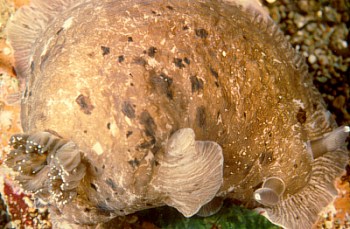
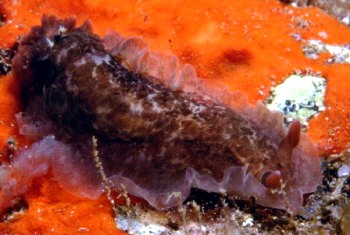
Dendrodoris grandiflora
Rapp, 1827
Order: NUDIBRANCHIA
Suborder: DORIDINA
Superfamily: EUDORIDOIDEA
Family: Dendrodorididae
DISTRIBUTION
Mediterranean, Atlantic coast from Portugal to Canary Islands.
PHOTO
UPPER: Photo: Conxita Avila.
LOWER: Gran Canaria Island, Canary Ids, off west African coast, divesite "Las Canteras". Size ~ 5 cm, depth 3 m, November 1998. Photo: Arthur J. Telle.
"Dendrodoris grandiflora (Rapp, 1827) lives in the Mediterranean Sea and Northeastern Atlantic, from Northern Portugal to the Canary Islands. It is in general a dark, reddish, yellowish, greenish or brownish species with dark spots on the dorsum. In general it has dark striations on the mantle margin. It never has a yellow line on the mantle edge." ..... Angel Valdes.
See Angel Valdes' discussion below on northeastern Atlantic dendrodorids.
See Marina Poddubetskaia Ossokine's message [#17131] discussing similarity of Dendrodoris grandiflora to D. senegalensis.
Reference:
• Valdes, A., Ortea, J., Avila, C. & Ballesteros, M. (1996) Review of the genus Dendrodoris Ehrenberg, 1831 (Gastropoda: Nudibranchia) in the Atlantic Ocean. Journal of Molluscan Studies, 62: 1-31.
Rudman, W.B., 2000 (May 24) Dendrodoris grandiflora Rapp, 1827. [In] Sea Slug Forum. Australian Museum, Sydney. Available from http://www.seaslugforum.net/find/dendgran
Related messages
Re: Dendrodoris grandiflora from the Mediterranean
April 3, 2009
From: Dominique Horst

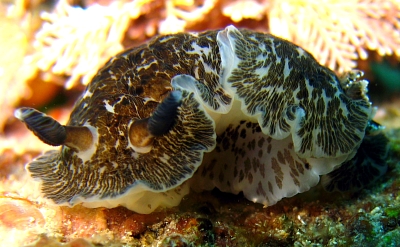
Concerning message #7553:
Hi Bill,
This is my first met with Dendrodoris grandiflora. I thought initially it was D. limbata, but looking at the pictures when back home, I've seen the striations on the mantle margin, a bit like in flat fishes.
Locality: Antibes, 11 m, France, Mediterranean sea, 28 March 2009. Length: 4 cm. Photographer: Dominique Horst.
Kind regards,
Dominique
dominique.horst@wanadoo.fr
Horst, D., 2009 (Apr 3) Re: Dendrodoris grandiflora from the Mediterranean. [Message in] Sea Slug Forum. Australian Museum, Sydney. Available from http://www.seaslugforum.net/find/22370
Thanks Dom,
Best wishes,
Bill Rudman
Dendrodoris grandiflora from southern Portugal
July 13, 2006
From: Carlos M. L. Afonso


Hello Bill,
Here are images of two different color variations of Dendrodoris grandiflora Rapp, 1827 collected under the same rock, in southern Portugal.
Locality: Between Albufeira and Armação de Pêra, 21-22 meters, Algarve, Portugal, Atlantic Ocean, 22 June 2006, Scuba diving. Length: more then 40mm. Photographer: Carlos M. L. Afonso (Lab. photo).
Best regards,
Carlos Manuel Lourenço Afonso
(Project RENSUB) FCMA/CCMAR
Universidade do Algarve
Campus de Gambelas
8005-139 Faro,
Algarve, Portugal
cmlafonso@ualg.pt
Afonso C. M. L., 2006 (Jul 13) Dendrodoris grandiflora from southern Portugal. [Message in] Sea Slug Forum. Australian Museum, Sydney. Available from http://www.seaslugforum.net/find/17106
Dear Carlos,
Thanks for these photos. The reddish one is certainly a colour variation we haven't had on the Forum before. It seems the best way to distinguish this species externally, is to look for the pattern of branching lines, almost like the veins of a leaf, which run across the mantle skirt.
Best wishes,
Bill Rudman
Dendrodoris grandiflora from Turkey
October 12, 2003
From: Ferda Buyukbaykal

Dear Bill,
Can you confirm this is Dendrodoris grandiflora please.
Date: September 20, 2003
Location: Ayvalik-Balikesir, Turkey
Site: Kerbela
Depth: 29 mt
Size: 15mm
Photos: Ferda Buyukbaykal
Thanks,
Ferda
ferdabbaykal@isnet.net.tr
Buyukbaykal, F., 2003 (Oct 12) Dendrodoris grandiflora from Turkey. [Message in] Sea Slug Forum. Australian Museum, Sydney. Available from http://www.seaslugforum.net/find/11205Dear Ferda,
The general colour pattern and the dark lines around the edge of the mantle are a good indication that this is Dendrodoris grandiflora
Best wishes
Bill Rudman
Dendrodoris grandiflora from the Mediterranean
August 1, 2002
From: Marina Poddubetskaia


Dear Bill,
Here is a photo of Dendrodoris grandiflora and a close-up of its gills (very nice gills). This animal was found under a stone.
Date: July 05, 2002
Location: Cerbere, France (Mediterranean)
Site: Les Chambres
Depth: 17m
Size: about 5cm
Best wishes,
Marina.
nembro@nembro.info
Poddubetskaia, M., 2002 (Aug 1) Dendrodoris grandiflora from the Mediterranean. [Message in] Sea Slug Forum. Australian Museum, Sydney. Available from http://www.seaslugforum.net/find/7553Thanks Marina,
Bill Rudman
Dendrodoris grandiflora from Spain
May 14, 2001
From: Miquel Pontes

Hello,
We found an specimen of Dendrodoris grandiflora in our last dive in the Costa Brava of Spain.
This slug was recorded in 5 meters of water, resting over a rock. After we shot many pictures we observed some kind of crustacean attaching to the posterior edge of its mantle [see lower photos]. It is probably a parasite but, can it be identified ?
We are also interested on the etymology of the species name "grandiflora". We think it's related to the nice gills of this nudibranch but it is uncertain.
Thank you,
Miquel
mpontes@marenostrum.org


Dear Miquel,
Thaks for the nice photos. Concerning the origin of its name, I think you are right about its gills. Many plants, especially those with large showy flowers, have the name 'grandiflora' and it is from the Latin words for 'large or prominent' and 'flower'. In the case of this Dendrodoris it almost certainly refers to the large flower-like' circle of gills.
Concerning the parasite. I have already sent your photo to an expert and will let you know what he thinks.
Best wishes,
Bill Rudman
Northeastern Atlantic Dendrodoris species
May 29, 2000
From: Ángel Valdés
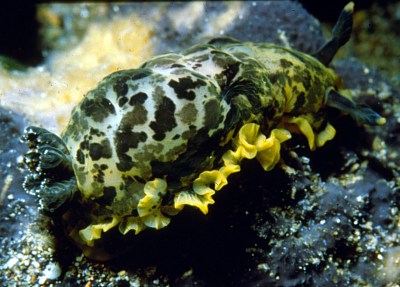
Dear Bill,
As far as we know there are only three species of Dendrodoris in the Northeastern Atlantic. I would not recommend to identify species based solely on the external morphology, but there are several characteristics that can give us a few clues.
UPPER RIGHT: Dendrodoris limbata (Cuvier, 1804) is endemic to the Mediterranean Sea. It is characterized by having a narrow mantle margin and a yellow (or whitish) line around the mantle edge. Some specimens are spotted and some are completely black, but all of them have the yellow line I mentioned. PHOTO: Conxita Avila.
LOWER LEFT: Dendrodoris grandiflora (Rapp, 1827) lives in the Mediterranean Sea and Northeastern Atlantic, from Northern Portugal to the Canary Islands. It is in general a dark, reddish, yellowish, greenish or brownish species with dark spots on the dorsum. In general it has dark striations on the mantle margin. It never has a yellow line on the mantle edge. PHOTO: Conxita Avila.
LOWER RIGHT: Dendrodoris herytra Valdés & Ortea, 1996 appears to be absent from the Mediterranean Sea, but it is the most widespread species in the Northeastern Atlantic. It lives from the coast of France to Canary Islands, Madeira and Azores. It is characterized by having a very small gill, and in general it is a red or reddish species. Some specimens can be greenish with dark spots, but the branchial leaves are always very short. PHOTO: Angel Valdes.
Juveniles of all Atlantic species of Dendrodoris, except D. limbata are uniformly red. I suspect specimens keep changing colors during their whole life, depending on what they eat. However, it is common to find under the same rock specimens of the same species with very different colorations.
The reproductive system, and especially the penial hooks are clearly different between these three species. As most of the visitors of the Sea Slug Forum know, species of Dendrodoris do not have a radula, and that makes the taxonomy of this group much more difficult.
I hope this will help.
Ángel
avaldes@calacademy.org
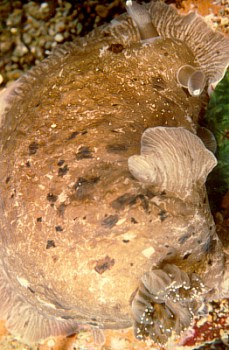
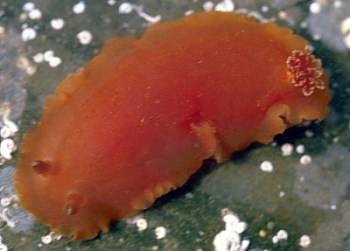
Dear Ángel,
Thanks for this. I am sure it will be of great help. It is interesting that the juveniles of so many Atlantic species are red, like the Indo-West Pacific species D. fumata and D. nigra.
Best wishes,
Bill Rudman.
Dendrodoris from the Canary Ids
May 26, 2000
From: Ángel Valdés
Dear Bill,
I think that animal showed in the picture by Erwin Koehler is indeed Dendrodoris grandiflora. There are two species of Dendrodoris in the Canary Islands, D. grandiflora and D. herytra. In general D. grandiflora is a gray species with dark spots, whereas D. herytra is uniformly reddish. However, there is a huge variability in color within the same species. The most accurate way to identify species is looking at the internal anatomy. The penial hooks are in my opinion the best taxonomic character. I know this is very frustrating for amateurs who do not have the time or the materials to study the anatomy of the nudibranchs they collect. I wish we could find a better way to distinguish species of Dendrodoris.
Angel
avaldes@calacademy.org
Valdes, A., 2000 (May 26) Dendrodoris from the Canary Ids. [Message in] Sea Slug Forum. Australian Museum, Sydney. Available from http://www.seaslugforum.net/find/2449Dear Ángel,
Thanks for the confirmation. As you say, many of the Atlantic species seems to be similarly coloured. Any comparative photos you have of them for the Forum would be welcome.
Best wishes,
Bill Rudman.
Re: Dendrodoris from Canary Ids
May 26, 2000
From: Juan Lucas Cervera
Dear Bill,
Yes, your ID is right.
Cheers.
Lucas.
lucas.cervera@uca.es
Cervera, J.L., 2000 (May 26) Re: Dendrodoris from Canary Ids. [Message in] Sea Slug Forum. Australian Museum, Sydney. Available from http://www.seaslugforum.net/find/2453Dendrodoris from Canary Ids
May 25, 2000
From: Eriwn Koehler

Dear Bill,
Here is a Dendrodoris from Gran Canaria Island, Canary Ids, off west
African coast, divesite "Las Canteras" made by Arthur J. Telle
email: mercedes@idecnet.com
Size ~ 5 cm, depth 3 m, November 1998.
Erwin
Medslugs.Koehler@t-online.de
Koehler, E., 2000 (May 25) Dendrodoris from Canary Ids. [Message in] Sea Slug Forum. Australian Museum, Sydney. Available from http://www.seaslugforum.net/find/2438Dear Erwin,
I am not an expert on the Atlantic fauna and according to Valdes, Ortea, Avila & Ballesteros (1996) there is quite a diverse fauna.
From their study I would identify this animal as Dendrodoris grandiflora.
Best wishes,
Bill Rudman.
Reference: Valdes, A., Ortea, J., Avila, C. & Ballesteros, M. (1996) Review of the genus Dendrodoris Ehrenberg, 1831 (Gastropoda: Nudibranchia) in the Atlantic Ocean. Journal of Molluscan Studies, 62: 1-31.
Rudman, W.B., 2000 (May 25). Comment on Dendrodoris from Canary Ids by Eriwn Koehler. [Message in] Sea Slug Forum. Australian Museum, Sydney. Available from http://www.seaslugforum.net/find/2438